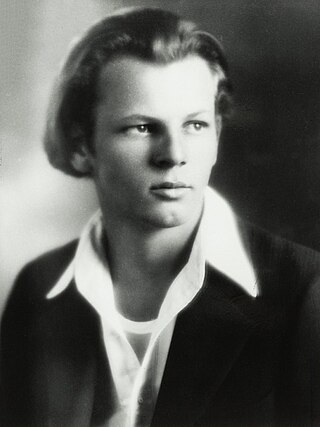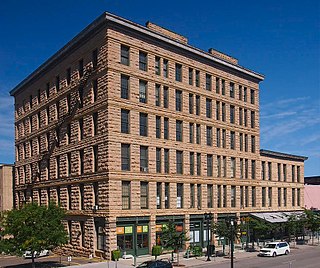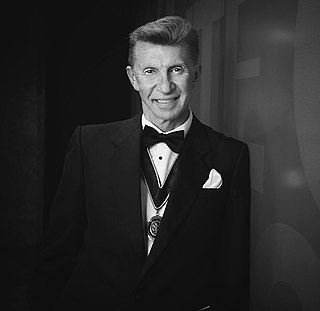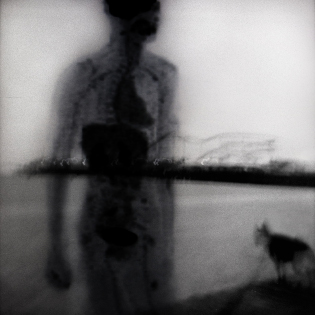
Paul Jackson Pollock was an American painter. A major figure in the abstract expressionist movement, Pollock was widely noticed for his "drip technique" of pouring or splashing liquid household paint onto a horizontal surface, enabling him to view and paint his canvases from all angles. It was called all-over painting and action painting, since he covered the entire canvas and used the force of his whole body to paint, often in a frenetic dancing style. This extreme form of abstraction divided critics: some praised the immediacy of the creation, while others derided the random effects.

Paradise is an unincorporated town and census-designated place (CDP) in Clark County, Nevada, United States, adjacent to the city of Las Vegas. It was formed on December 8, 1950. Its population was 191,238 at the 2020 census, making it the fifth-most-populous CDP in the United States; if it were an incorporated city, it would be the fifth-largest in Nevada. As an unincorporated town, it is governed by the Clark County Commission with input from the Paradise Town Advisory Board.

The Las Vegas Valley is a major metropolitan area in the southern part of the U.S. state of Nevada, and the second largest in the Southwestern United States. The state's largest urban agglomeration, the Las Vegas Metropolitan Statistical Area is coextensive since 2003 with Clark County, Nevada. The Valley is largely defined by the Las Vegas Valley landform, a 600 sq mi (1,600 km2) basin area surrounded by mountains to the north, south, east and west of the metropolitan area. The Valley is home to the three largest incorporated cities in Nevada: Las Vegas, Henderson and North Las Vegas. Eleven unincorporated towns governed by the Clark County government are part of the Las Vegas Township and constitute the largest community in the state of Nevada.

Kyle Ranch or Kiel Ranch, was one of the earliest ranches established in Nevada's Las Vegas Valley. Founded by Conrad Kiel in 1875, today the location of the former ranch is in North Las Vegas, where the city maintains the remnants of the site as the "Kiel Ranch Historic Park." The original adobe structure, one of the oldest buildings in Las Vegas, a wooden shed known as the "Doll House," and the cemetery are all that remain after loss of buildings through fire and neglect. Also within the park is an artesian well and a small wetlands, a reminder of what drew travelers and early settlers to the area. Presently the ranch's location is memorialized with Nevada Historical Marker number 224.

Robin Slonina is a multi-disciplinary, contemporary artist.
David Orentlicher is an educator, physician, attorney, and an American politician. He is a member of the Democratic Party and is the Judge Jack and Lulu Lehman Professor at UNLV William S. Boyd School of Law and co-director of the UNLV Health Law Program. He teaches courses in health care law and constitutional law. Orentlicher also has held visiting or adjunct teaching positions at Princeton University, the University of Chicago Law School, Indiana University: Robert H. McKinney School of Law, University of Iowa College of Law, and Northwestern University Medical School.

The Traffic Zone Center for Visual Art (TZCVA) is an artist cooperative located in the historic Warehouse District of downtown Minneapolis, Minnesota, United States. Founded in 1993, TZCVA was established to create an artist-owned and managed building that provides stable, safe, and affordable studio, teaching and exhibition space for mid-career visual artists. TZCVA is a partnership between Artspace Projects, Inc., a leading national non-profit real estate developer for the arts, and a cooperative of 23 artist-members.
The Las Vegas Art Museum was an art museum in Las Vegas, Nevada. It was formerly located in a building shared with the Sahara West Library branch of the Las Vegas-Clark County Library District in Las Vegas, NV. The museum closed in 2009.
Josh Azzarella is an American artist based in New York, New York. He was born in Ohio.
Claudia Keelan is an American poet, writer, and professor. She received the Regents’ Creative Activities Award, at the University of Nevada, Las Vegas.
The Marjorie Barrick Museum of Art is a museum located on the main campus of the University of Nevada, Las Vegas (UNLV), established in 1967. The museum was originally instituted as a natural history museum with a focus on the natural history and environment of Nevada and the broader Southwestern United States. In December 2011, the Barrick joined the UNLV College of Fine Arts and became the anchor of the Galleries at UNLV. The six galleries and one museum that make up the Galleries are each entities in their own right linked via a common administration.
James Parsons Dalglish is an American abstract painter. He lives and works in New York City.
Justin Favela is an American mixed-media artist who is known for making large-scale installations and sculptures in the piñata style or medium. His work references pop culture, art history, society, cultural commentary, and his own Guatemala-Mexican-American heritage that is rooted in growing up in Las Vegas, Nevada. His works often celebrate his identity as a queer person of color raised in the Southwest United States while challenging the ideas of Latinidad and cultural appropriation.

Laurens Tan is a multidisciplinary Australian artist. His work includes sculpture, 3D animation, video, and graphics, and is influenced by architectural and industrial design. He lives and works in Sydney, Beijing, and Las Vegas.

Edward A. Vance, FAIA, an American architect, is the principal-in-charge of design and CEO at EV&A Architects, a specialty architecture firm he founded in Las Vegas, Nevada in 2006. Vance has been a registered Architect in 19 states and is certified by the National Council of Architectural Registration Boards (NCARB). He served as the 2019 Chancellor of the American Institute of Architects College of Fellows.

Rita Asfour was an American modern artist. She was known for her colorful aesthetic paintings of the human figure. Rita projected life and movement by the strength of her compositions. Feminine mystique and sensuality were her trademark.
Marjorie Ann Jacobson was a founding member of the University of Nevada, Las Vegas Foundation Board of Trustees. She was born in Iowa in 1917.

Rita Deanin Abbey was a multidisciplinary abstract artist and among the first art professors at the University of Nevada, Las Vegas (UNLV). Born in New Jersey to Polish immigrants, she moved to Las Vegas, Nevada, in 1965 to teach, living there for 56 years and contributing several large-scale public artworks. She was an artist-in-residence at the studios of many artists and institutions, had over 60 individual exhibitions, and participated in over 160 national and international group exhibitions.

Linda Alterwitz is an American visual artist whose work Integrates art, science and technology, investigating the inner workings of the human body and its connection to the natural world and cosmos. Her practice includes photographic and collaged works, immersive installations and participatory methods, and employs alternative imaging devices ranging from low-tech plastic cameras to advanced medical diagnostic machines. Her complex images frequently superimpose medical visualizations onto abstracted portraits and landscapes, blurring distinctions between the outer body, its underlying systems and organs, and the external environment.

Artur Silva is a Brazilian artist who works in Indianapolis in the United States. His work has been shown at the Ludwig Foundation, the VanAbbe Museum, the Smart Museum, the Indiana State Museum, and the Centro Cultural de España. His work has resulted in awards and fellowships, including from the Pollock-Krasner Foundation, the Foundation for Contemporary Arts, the Arts Council of Indiana, the Efroymson Contemporary Art Fellowship from the Central Indiana Community Foundation, and the Christel DeHaan Artist of Distinction Award.











